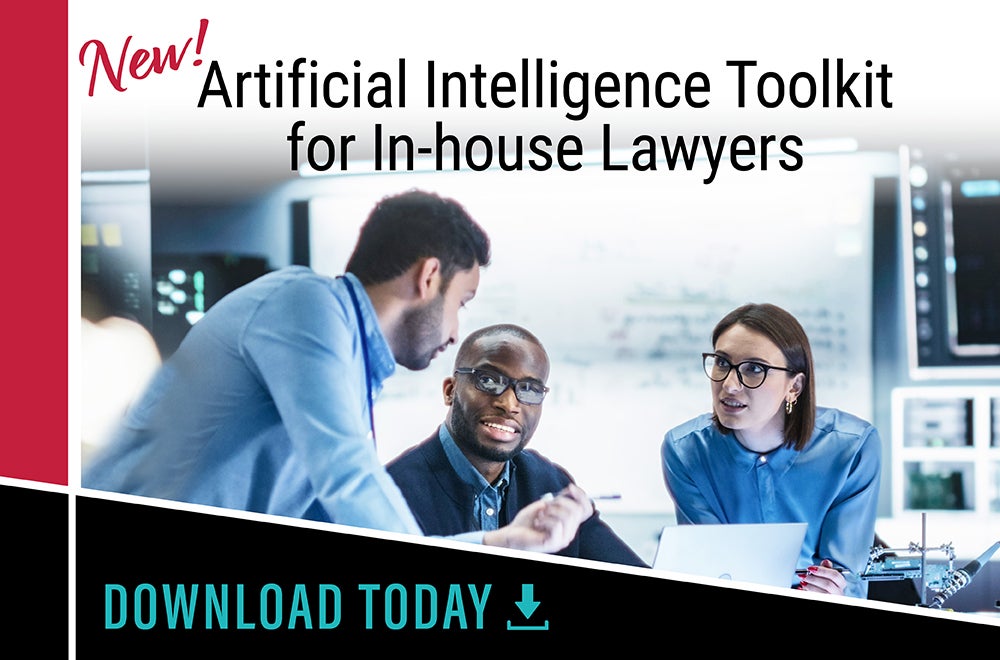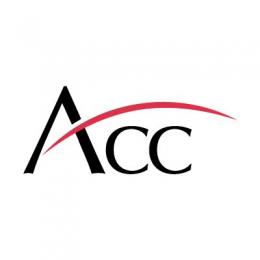Banner artwork by drmvisioner / Shutterstock.com
The “AI wave” is upon lawyers. And there are analogies between surfing and AI:
- Surfing looks easy and fun. Yet, it requires training, precautions, and practice.
- Learning how to surf takes time, perseverance, and adequate gear. It requires learning how to use tools and navigate the landscape — such as how to read the pattern of incoming waves.
- It involves risks of harm and requires precautions — such as knowing how to swim and dive, how to protect your head and neck during falls, being mindful of people, currents, etc. (Disclaimer: This is not a surfing tutorial — please learn with a professional surf coach!)
As fun as the surfing analogy may be, a notable difference is that while learning how to surf is not a professional requirement for lawyers (thankfully), they do need to learn how to use AI and help the business navigate opportunities and risks.
Lawyers must adapt and adopt AI technology to remain competitive. Still, only 42 percent of surveyed in-house lawyers feel prepared for the impact of Generative AI — the most popular type of AI tools — on their career, according to survey findings by ACC and Everlaw.
Zooming out, AI raises many questions beyond its use to advance business purposes and perform legal work — for example, regarding the potential impact on users’ analytical, creative, and critical thinking skills; the potential displacement of jobs due to the introduction of AI-powered processes; or regarding energy and environmental implications. This article focuses on how in-house lawyers can approach the growing use of AI in the organizations they serve and in their work.
New! The ACC AI Center of Excellence for In-house Counsel is a brand new resource, designed specifically for in-house counsel, to help legal departments navigate AI with clarity and confidence. The AI Center of Excellence will offer:
- Curated tools and insights
- Peer learning from real-world use cases
- Ethics, risk and governance frameworks, and guidance tailored for Legal
- Leadership strategies for the AI era
Below are insights and practical tips to help in-house lawyers scan the landscape and succeed in their AI journey.
A wealth of checklists, insights, and sample tools are also featured in ACC’s newly released Artificial Intelligence Toolkit for In-house Lawyers, for which in-house legal professionals from the ACC community and attorneys from Kilpatrick Townsend & Stockton LLP contributed practical insight — with thanks to Christopher Oberst, ACC Legal Resources Specialist, for his very substantial work as lead editor of the toolkit.
Adapting to AI is a competitive imperative
The AI wave unlocks new opportunities and challenges for business and legal teams. Not adapting doesn’t seem like a viable business option, nor is it an advisable course of action, in light of lawyers’ duty of competence.
Business teams are already paddling vigorously to benefit from AI’s capabilities. In-house lawyers need to help guide business colleagues’ use of AI, keep track of regulatory currents, learn to ride the AI wave for their own legal work, and navigate potential ethical pitfalls.
No matter the industry in which a business operates, its competitors — and their respective in-house legal teams — are likely exploring or investing in AI technology, to improve their operations and products and gain a competitive edge.
Law firms are developing or using AI tools and models to adapt their operations and be more efficient. Clients will likely expect outside counsel to improve the quality and efficiency of legal services, and to reflect savings in the amount and structure of legal fees.
In-house legal teams are also adopting AI technology to provide more efficient and user-friendly services to their respective organizations.

Lawyers have a role in shaping the course of the AI wave
Unlike oceanic swells, the AI wave is driven by human innovation and influences. Its course is shaped by human factors such as technical advances and limitations, societal expectations and usage, and rules and guidance set by governing authorities.
Through their work, lawyers have a role to play in steering the course of this wave.
They have the opportunity — and are expected — to guide the business in how AI products and functionalities are designed, developed, and deployed. In-house lawyers foster legal and regulatory compliance, participate in the public dialogue regarding the implications of AI, and help in efforts to develop balanced standards and regulatory frameworks.
Spotlight: The role of the CLO in shaping the course of AI
- Chief legal officers are particularly well positioned to shape the evolution of AI, guide its strategic adoption, and advance business strategies — especially when the CLO has a direct reporting line to the CEO and access to the board of directors.
- The rise of AI offers a significant example of why a direct reporting line to the CEO and access to the board are important, given the enterprise-wide opportunities and risks of artificial intelligence.
- CLOs have a broad perspective of enterprise functions and units. They’re adept at balancing strategy, compliance, and risks, and anticipating the ripple effects of emerging trends and strategic decisions throughout the organization.
- This equips CLOs to bring a much-needed holistic perspective as part of their organization’s senior leadership, with a view to advancing corporate strategies while mitigating risks.
- CLOs are also well-positioned to liaise with authorities and other external stakeholders who contribute to the discussion, development, and implementation of standards and regulatory frameworks that guide the course of the AI wave.
Six tips to harness AI capabilities
Focus on strategies that help you make a difference. Below are six high-level tips to consider. More detailed strategies and insights by experienced in-house lawyers and law firm attorneys are available in the ACC Artificial Intelligence Toolkit for In-house Lawyers. (Note: the information in this article does not constitute legal advice and shouldn’t be construed as a legal opinion.)
- Identify specific AI use cases that help business teams work more efficiently, deliver better services, and make a measurable difference in advancing strategic goals. Also consider how AI solutions can foster efficiency and automate processes for the legal department itself, while staying compliant with lawyers’ professional rules and duties. Consider focusing on a few use cases and investing the time and resources needed to vet, test, and implement those effectively.
- Develop an AI governance system and policies that foster responsible use of AI tools.
- Establish a workable governance structure that guides the development and implementation of the organization’s AI strategy and policies.
- Develop user-friendly guidelines, and set clear guardrails regarding high-risk uses.
- Consider incorporating AI guidelines into your existing policies on topics, such as:
- Employment
- Human resources
- Cybersecurity
- Information governance
- Privacy
- Contract review and negotiation
- Develop a protocol for vetting the AI tools that teams wish to use.
- Involve business stakeholders in the development of AI governance.
- Design processes that balance the “speed of business,” compliance needs, and risk mitigation. If protocols or policies are overcomplicated, unduly burdensome, or too time-consuming, the AI governance system could lose credibility. Business units might end up treating it as an unrealistic hindrance, and bypass steps or ignore the process altogether.
Spotlight: When evaluating the risks associated with a proposed AI tool, consider these four risk factors shared by Gregory P. Silberman, counsel at Kilpatrick Townsend & Stockton LLP: privacy; security; trust and safety; and bias and fairness. Learn more with the checklist: Evaluate Four Key Risk Factors in AI Systems, by Gregory P. Silberman, in the ACC AI Toolkit for In-house Lawyers (Kilpatrick is the sponsor of the ACC toolkit).
- Invest in training for your workforce, to ensure they understand the limits of acceptable use and how to make the most of the AI tools allowed (e.g., prompting techniques).
- AI adoption likely requires learning and adaptation within the workforce.
- Help senior leadership set the tone, develop a plan that includes all enterprise levels and functions, and shape your organization’s AI culture.
- Periodically refresh training programs to adapt to new changes in the AI landscape and in the organization’s use cases.
- Foster knowledge sharing within your organization, so teams can help each other learn from their respective experiences with AI.
- Ensure that your workforce’s use of AI tools won’t jeopardize the organization’s assets or infringe third parties’ intellectual property rights.
- Keep in mind that in many jurisdictions, creation by a human being is key to ensuring that content can be protected under intellectual property laws.
- Help business teams understand the implications of how they use AI technology to develop corporate assets (such as written or visual content, code, etc.), and whether their process will allow the organization to assert IP rights.
- Consider how to mitigate AI-related risks in contracts with third parties. Among other issues, address data privacy and cybersecurity risks. Also consider your organization’s potential liability arising from the use of AI tools by vendors or subcontractors - for example, if they use such tools to process personal information or to produce deliverables that your company will use.
- Continuously learn and adapt. Keep educating yourself, stay nimble, and adapt your business’s AI governance.
- Given the fast-paced growth of AI capabilities, this will likely require time, effort, and discipline.
- Continue to learn about new developments and trends (consider joining an ACC Network).
- Maintain an ongoing dialogue with your business teams.
- Revise and adapt your governance structure, policies, and processes as needed, for your business to remain competitive and compliant.
You can do this — get on your (metaphorical) board, learn to navigate the AI wave, and help to steer the course of your organization’s AI journey. And know that the global ACC in-house community, with more than 48,000 members, is there for you to learn, network, and succeed in harnessing the power of AI — wave after wave.
Learn More. Equip yourself with practical insights and strategies, through the checklists and tools featured in the ACC Artificial Intelligence Toolkit for In-house Lawyers, an ACC resource sponsored by Kilpatrick Townsend & Stockton LLP:
- Scan the landscape: Key ACC survey findings on in-house and AI.
- Anticipate: An outlook on 10 AI trends in 2025.
- Increase your skills: Nine checklists to help you succeed in your AI journey.
- Save time: A selection of tools and resources to support your in-house success with AI.
Disclaimer: The information in any resource in this website should not be construed as legal advice or as a legal opinion on specific facts, and should not be considered representing the views of its authors, its sponsors, and/or ACC. These resources are not intended as a definitive statement on the subject addressed. Rather, they are intended to serve as a tool providing practical guidance and references for the busy in-house practitioner and other readers.




